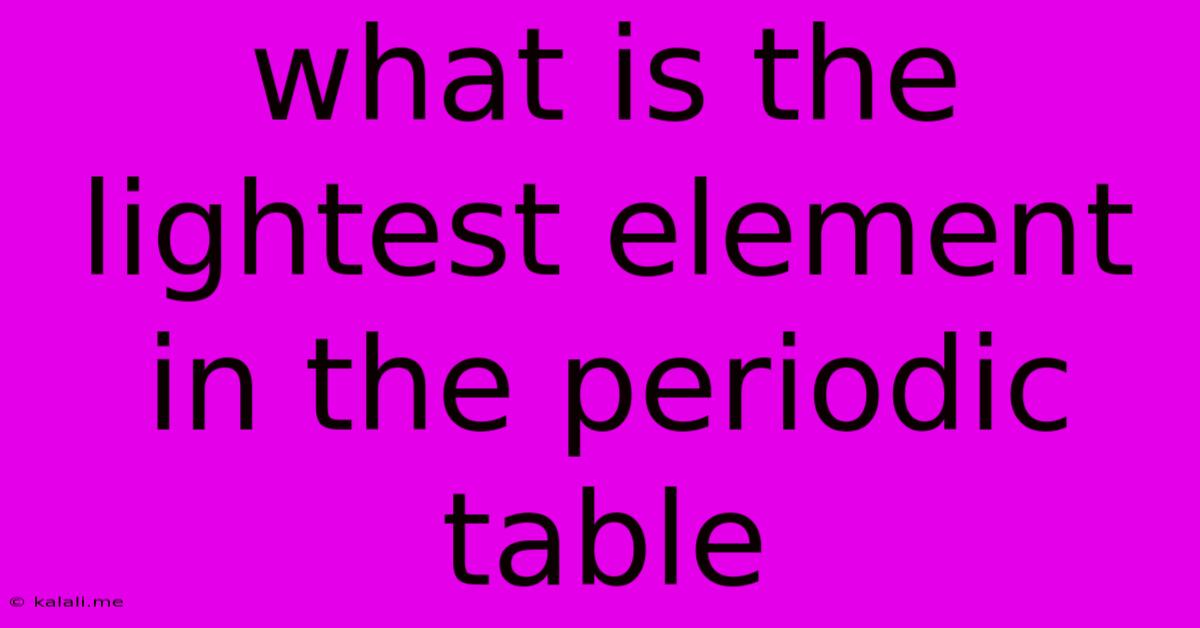What Is The Lightest Element In The Periodic Table
Kalali
Jun 14, 2025 · 3 min read

Table of Contents
What is the Lightest Element in the Periodic Table?
The lightest element in the periodic table is hydrogen, possessing the lowest atomic weight and density. This seemingly simple element plays a crucial role in the universe and is fundamental to life as we know it. Understanding its properties and significance provides a fascinating insight into the building blocks of matter. This article will delve into the unique characteristics of hydrogen and explore why it holds this distinctive title.
Defining "Lightest" in the Context of Elements
When we discuss the "lightest" element, we're referring to two key properties: atomic mass and density. Hydrogen wins on both counts. Its atomic mass, approximately 1 atomic mass unit (amu), is significantly lower than any other element. Density, representing mass per unit volume, is also remarkably low for hydrogen, particularly in its gaseous state.
Unique Properties of Hydrogen
Hydrogen's lightness isn't its only remarkable feature. It possesses several other unique properties that contribute to its importance:
- Abundance: Hydrogen is the most abundant element in the universe, constituting roughly 75% of all baryonic matter. It's found extensively in stars and interstellar clouds.
- Reactivity: While relatively inert in its diatomic form (H₂), hydrogen can readily react with other elements to form various compounds, including water (H₂O) and many organic molecules.
- Isotopes: Hydrogen exists in three isotopes: protium (¹H), deuterium (²H), and tritium (³H). These isotopes differ in their neutron count, affecting their mass and properties. Deuterium and tritium are particularly important in nuclear research and applications.
- Energy Potential: Hydrogen is considered a promising fuel source for the future due to its clean combustion process, producing only water as a byproduct. Research into hydrogen fuel cells is advancing rapidly.
Hydrogen's Role in the Universe and on Earth
Hydrogen's prevalence and reactivity are essential for various processes:
- Stellar Nucleosynthesis: Hydrogen fusion within stars is the primary source of energy in the universe. This process converts hydrogen into helium, releasing enormous amounts of energy.
- Water Formation: Hydrogen is a crucial component of water, making it fundamental to life on Earth and the processes that sustain our planet's ecosystems.
- Organic Chemistry: Hydrogen forms the backbone of many organic molecules, including carbohydrates, lipids, proteins, and nucleic acids—the fundamental building blocks of life.
Comparing Hydrogen to other Light Elements
While helium is the next lightest element, its atomic mass (approximately 4 amu) and density are significantly higher than hydrogen's. This difference underscores hydrogen's unique position at the top of the periodic table. Other light elements, such as lithium and beryllium, are even heavier and denser.
Conclusion: Hydrogen's Reign as the Lightest Element
In conclusion, hydrogen undeniably holds the title of the lightest element in the periodic table. Its low atomic mass and density, coupled with its abundance, reactivity, and crucial role in various natural processes, solidify its significance in the universe and on Earth. Further research and applications continue to reveal the multifaceted nature of this remarkable element.
Latest Posts
Latest Posts
-
Example Of Solid Dissolved In Solid
Jun 14, 2025
-
Air Pressure At Sea Level Is Equal To
Jun 14, 2025
-
What Is The Opposite Of Reluctant
Jun 14, 2025
-
Brass Is A Mixture Of What
Jun 14, 2025
-
Which Of The Following Are Pure Substances
Jun 14, 2025
Related Post
Thank you for visiting our website which covers about What Is The Lightest Element In The Periodic Table . We hope the information provided has been useful to you. Feel free to contact us if you have any questions or need further assistance. See you next time and don't miss to bookmark.